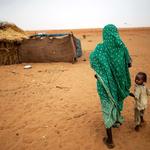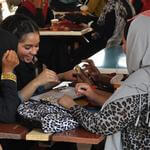A fight against child marriage is a fight against tradition
‘If girls are not married and are allowed to continue their education, they may be immoral and dishonor the families’
Man in group discussion
Each year, 15 million girls are married before the age of 18. Many of them live in Sudan, which is one of the African countries where child marriage does not even raise an eyebrow. 10.7 % of Sudanese women are married before 15 years of age, 38 % are married before they turn 18.
Poverty is often identified as a main driver of child marriage. Yet, research findings from the Red Sea State in Sudan tell a different story; a story of tradition, cultural norms, social pressure and stigma.
-Child marriage is driven by tradition, not poverty, says Ahmed Mohamed Tahir at the University of Red Sea and part of the ARUSS (Assisting regional universities in Sudan and South Sudan) research team.
Turning young girls into obedient wives
Through extensive field work and interviews, the researchers on the ARUSS programme have explored local communities’ attitudes towards child marriage, and found that child marriage more than anything else is about control mechanisms, about making sure that young girls keep pure and chaste, and about turning them into obedient wives.
‘Marrying girls during childhood enables the husband to socialize her to be submissive and obey him and his family’
Middle-aged man in interview
Poverty and lack of schools are rarely mentioned as decisive factors. What comes across in the interviews is a clear pattern of tradition and discrimination. Protection, stigma and obedience are the main drivers; there is a general view that girls have to be protected from immoral behaviour, that it is shameful for a family to have daughters that are deemed to be unfit for marriage and that women are supposed to be subordinate. For the communities, child marriage is a magic bullet that helps families avoid social stigma. Child marriage by simple logic prevents young girls from having extra-marital sex. It rids parents of the fear that their daughters will be deemed as unfit for marriage, and the saying goes that marriage at a young age makes it easier to shape young girls into the kind of wife that men want; a wife that does what she is told and never argues with her husband.
‘The complications of child marriage are easier for me to tolerate than having my daughter stigmatized as bayra. I married my first daughter at 14 years of age and will not hesitate to do the same for her sisters’
Male director of a girls’ primary school in Red Sea
The fear of stigma and shame weighs heavier than the well-being of young girls.
-Young girls are rarely consulted before the wedding takes place. They are simply informed about what is going to happen, says Ibtisam Al Jack, ARUSS researcher from the University of Gedarif.
Practicing child marriage despite knowledge about detrimental effects
Child marriages have negative and sometimes detrimental effects on the lives of young girls. Early pregnancies increase the risk of maternal and child mortality as well as fistula. Young brides are economically dependent on often older husbands and will divorce early; and since young girls are forced to leave school upon marriage, their life opportunities are limited once they are divorced. Honour, image and perceptions about the importance of girls ‘chastity are so all-encompassing that detrimental health consequences of child marriage do not stop communities from practicing it.
- Our research shows that practicing communities clearly are well aware of the harmful consequences of child marriage. Lack of information is not the issue. Still, interventions keep focusing on informing people about the negative health effects. Anti-child marriage advocates need to reconsider their approach. Future interventions must be founded in a close cooperation between researchers, NGOs and religious leaders, says Ibtisam Al Jack.
Failed reform attempts
Currently, many interventions are inefficient because they do not consider the costs of social stigma, and because they do not address the root causes of child marriage, they miss the target.
However, the attitudes are slowly changing. Local NGOs and the Red Sea State Child Welfare Council have run awareness raising projects in the Red Sea state for years.
-An increasing number of unmarried girls and young women are finishing schools and entering universities. But they still do this at the social cost of being stigmatized as agir (unfertile) or bayra (unfit for marriage), says Liv Tønnessen, ARUSS researcher and research director at CMI.
Attitudes are hard to change, and anti-child marriage advocates often fight their cause in a tense atmosphere. Fear of resistance from tribal leaders cause many interventions to be pushed and carried out timidly. Anti-child marriage advocates also risk being perceived as anti-government. Sudan still lacks a law that criminalizes child marriage, despite reform attempts. A law reform would change their chances of getting their message across, argues Tønnessen.
- A law that forbids child marriage is in itself no guarantee of an end to child marriage, but it will make life easier for anti-child marriage advocates. Until activists can fight child marriage with support from the law, they risk being perceived as anti-government, she says.
Liv Tønnessen is a columnist in Bistandsaktuelt. Read her latest column on child marriage (in Norwegian) here.
Publication

Girls, Child Marriage, and Education in Red Sea State, Sudan: Perspectives on Girls’ Freedom to Choose
Liv Tønnessen
Project

